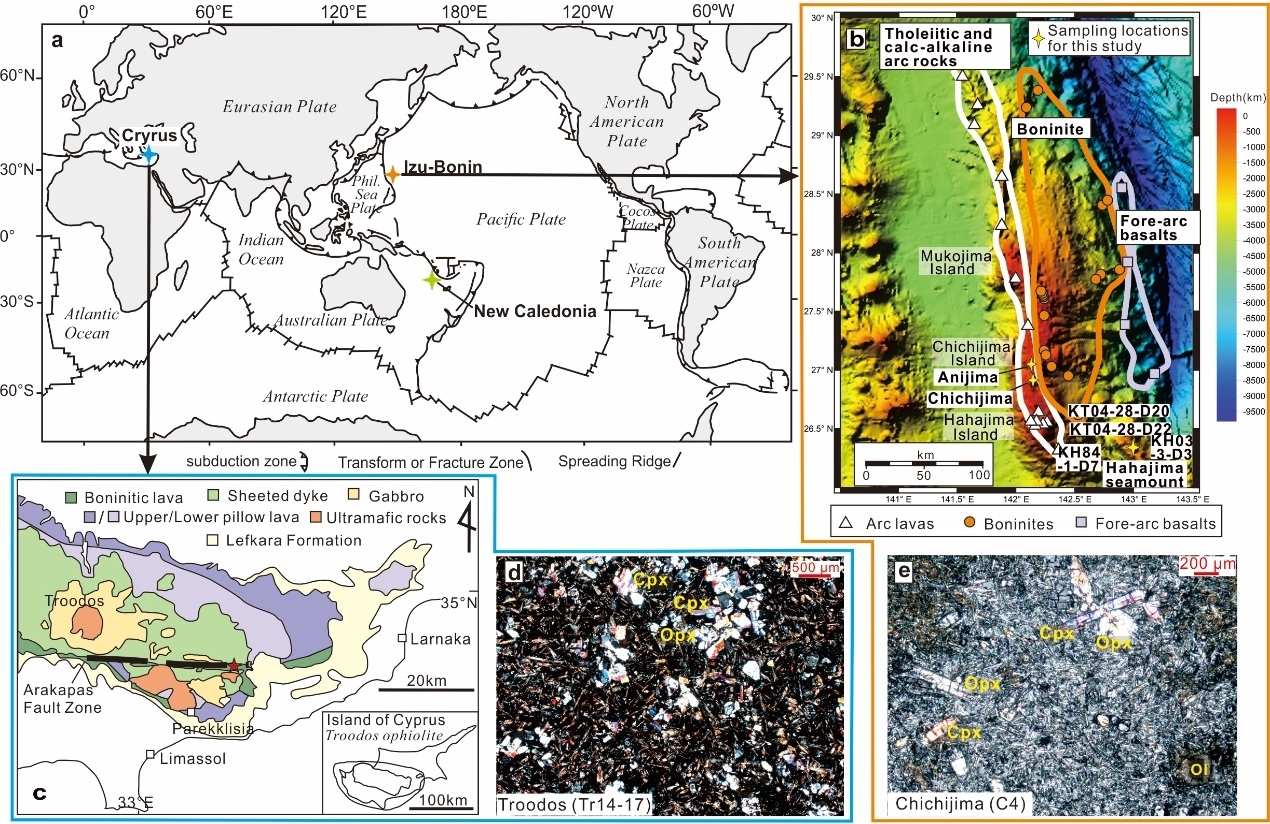Study Reveals Heterogeneous Mantle Source Compositions for Boninite from Bonin and Troodos
Subduction-zone magmas are characterized by high fluid contents and Fe3+/ΣFe ratios, which are closely associated with slab-derived fluids during subduction. However, instead of a heavier iron isotope composition preferred under an oxidized state, arc magmas have lighter iron isotope compositions than seafloor basalts, including mid-ocean ridge basalts (MORB) and oceanic island basalts (OIB). It remains unclear whether the lighter iron isotope composition of subduction-related magmas is inherited from the depleted mantle source or caused by the addition of slab-derived oxidized fluids.
Recently, the research team led by Prof. XIAO Yuanyuan from the Institute of Oceanology of the Chinese Academy of Sciences (IOCAS) and co-authors reported new Fe isotope data for low-Ca boninite from Bonin islands and submarine forearc (CaO/Al2O3 mainly < 0.75) and high-Ca boninite from Troodos ophiolite complex (CaO/Al2O3 = c. 0.85), which is thought to result from melting of highly depleted refractory mantle with varying effects of slab-derived fluids.
The study was published in Lithos on May. 22.
Researchers found that the δ56Fe values of the Bonin boninite are highly variable (ranging from -0.046 ± 0.003‰ to 0.078 ± 0.031‰), which are affected by mineral cumulates, while the δ56Fe values of the Troodos boninite are relatively uniform (from 0.046 ± 0.010‰ to 0.091 ± 0.016‰ with an average of 0.06 ± 0.01‰, n = 7). Together with the literature data on boninite from New Caledonia, the average δ56Fe value of the Troodos high-Ca boninite is higher than those of low-Ca boninite from Bonin and New Caledonia, the latter of which was originated from a more refractory mantle source. Thus, the iron isotope variation of boninite among different sample suites reflects the heterogeneous mantle composition caused by different prior depletion histories.
In addition, researchers found an inverse correlation of decreasing δ56Fe with increasing Ba/La in the Troodos boninite, reflecting the addition of aqueous fluids in the mantle source for metasomatism during the long evolution history before melting. On the other hand, the Bonin boninite magma is best understood as resulting from melting of highly refractory mantle mixed with slab-derived melts. This study shows that the effects of subduction component on iron isotope composition of boninite may be limited (e.g., Troodos boninite) or have been hidden (e.g., Bonin boninite), while the influence of highly refractory mantle sources is more significant, which may also be responsible for a relatively lighter iron isotope composition of subduction-related magmas than seafloor basalts.
"Given the limited data for iron isotope composition of boninite so far available, it is thus required to systematically study iron isotope composition of boninite with different compositions to further understand the petrogenesis of boninite and the iron isotope variation of subduction-related magmas," said Pro. XIAO.
This work was supported by the National Natural Science Foundation of China, Science and Technology Innovation Project of Laoshan Laboratory, Special project of strategic leading science and technology of Chinese Academy of Sciences, etc.

Fig. 1 Locations of the three most representative boninite outcrops on modern Earth. Bathymetry of the IBM arc system and geological sketch of Cyrus with sample locations are given (revised after Ishizuka et al., 2020; Li et al., 2013), as well as representative photomicrographs of Bonin and Troodos boninite samples in this study.

Fig. 2 The δ56Fe isotope variation among different boninite sampling suites.
Yuanyuan Xiao*, Yongxiang Yao, Zihang Huang, Yi-Bing Li*, Yaoling Niu, Teruaki Ishii, Ziwei Sun, Hongmei Gong, Xiaohong Wang. (2023). Heterogeneous mantle source compositions for boninite for Bonin and Troodos, evidence from iron isotope variations. Lithos.
(Text by XIAO Yuanyuan, Yao Yongxiang, SUN Ziwei)
Media Contact:
ZHANG Yiyi
Institute of Oceanology
E-mail: zhangyiyi@qdio.ac.cn
(Editor: ZHANG Yiyi)